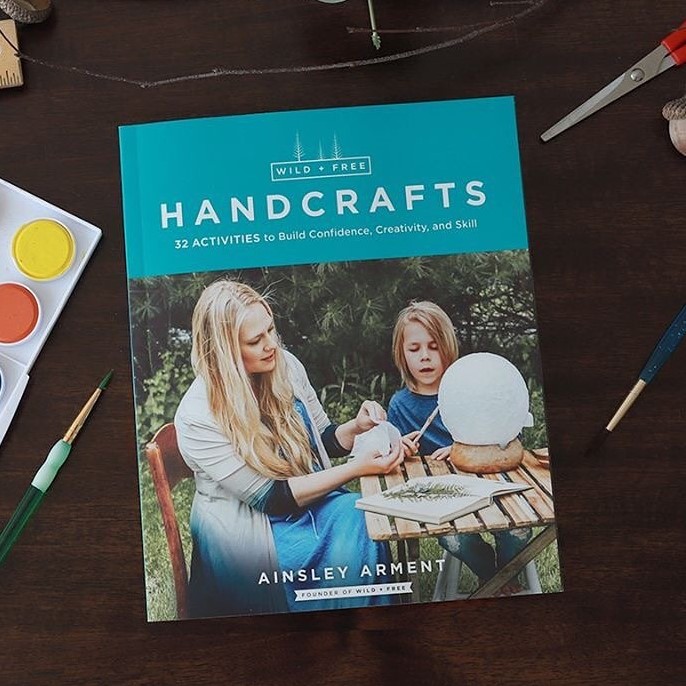The work of childhood ought to be filled with joyful discovery. – Charlotte Mason
As a child I loved creating with my hands, no matter the season. Summer daisy chains and mud pies, autumnal pocket treasures, frosty window drawings, and pressed spring flowers float through my childhood memories, like sparkles in a stream of sunshine. When my mother gave me a journal for my pressed flowers and drawings, I didn’t think of what I put in it as work but as an extension of my play.
This is how we ought to approach the task of teaching handwork to young children. Just think how readily a young child, holds a crayon, plucks a flower, stirs a cake mix, and hammers a nail. How eager they are to learn more!
So, where do you begin?
Below are three suggestions for teaching handwork successfully to young children.
1. Set high expectations with attainable goals.
Difficulty produces the necessary pressure to develop character. Children who experience the challenge of beginning, persevering and completing handwork are better able to handle this same kind of pressure in other areas of their life.
For example, if a student makes a mess of her finger knitting and can be encouraged to start over again, and even a third time, in order to do the job correctly, the joy of a job well done through effort and concentration will spur that same child on when she’s faced with a perplexing math problem or a science project that goes awry.
Teaching children to struggle through a new learned task requires maintaining an attitude of joyful discovery. Use phrases such as, “You can do this. Let’s work hard and focus our attention.” Or, “This will be worth the effort you’re putting into it.” Or, “I’m so glad to be here doing this with you.” This type of encouragement will be needed in those moments of frustration. Of course, breaks will be needed. However, don’t wait too long to jump back in and try again. Always end your time positively. Say something like, “Oh, look, you have hammered three nails in the board. Let’s take a break and come back to try again.” This will keep the project and motivation alive.
Do beware of unattainable goals. Five-year-olds can certainly learn to weave a simple pot holder but may be undone by a large-scale project like a carpet. Begin with just enough challenge for a bit of struggle that will end in the joy of accomplishment.
2. Choose what is beautiful and useful.
Avoid projects that will end up in the trash bin. Look for something that will be not only beautiful but useful. A birdhouse, a stuffed animal, a pot holder, a perforated picture worthy of framing, a needle-pointed tea towel – all of these are useful projects. Go even further by intertwining handwork with your curriculum. For example, finger-knit bunnies can initiate imaginative play based on rich texts you’ve been reading, such as Beatrix Potter’s Benjamin Bunny. Watch children eagerly act out the story with their beautiful creations. Or, use carved hiking sticks to go on a nature walk that may lead to the discovery of new flora and fauna.
3. Take your time.
Beware rushing to the end product. There’s joy to be found in the long-term effort of perforating paper masterpieces or creating a work of art. Your projects ought to take several days if not several weeks to complete. Enjoy the time together by setting a specific location inside or outside to work together. Play classical music, and create an atmosphere that provides a sense of peace and gives permission to slow down.
Through every season work with your hands alongside your child. Treasure dewy mornings weaving grasses by the creek or sunlit hours finger knitting under the willow trees. Cherish long hikes with your handmade sticks through golden forests, or cozy evenings whittling by the fire. Time is a lovely thing. May your time in handwork with your children create beautiful moments that will sparkle in their memories for years to come.
Copyright 2018, The Old Schoolhouse®. Used with permission. All rights reserved by the Author. Originally appeared in the Winter 2018/2019 issue of The Old Schoolhouse® Magazine, the trade publication for homeschool moms.
Would you like to add more handwork to your homeschool, but you’re not sure where to start? Check out Wild + Free Handcrafts: 32 Activities to Build Confidence, Character and Skill by Ainsley Arment.

Enjoy this post? Read on, and sign up for our homeschool newsletter!
Inside a Charlotte Mason Homeschool
Discover Your Family’s Homeschooling Style
The Call of the Wild + Free: An Interview with Ainsley Arment